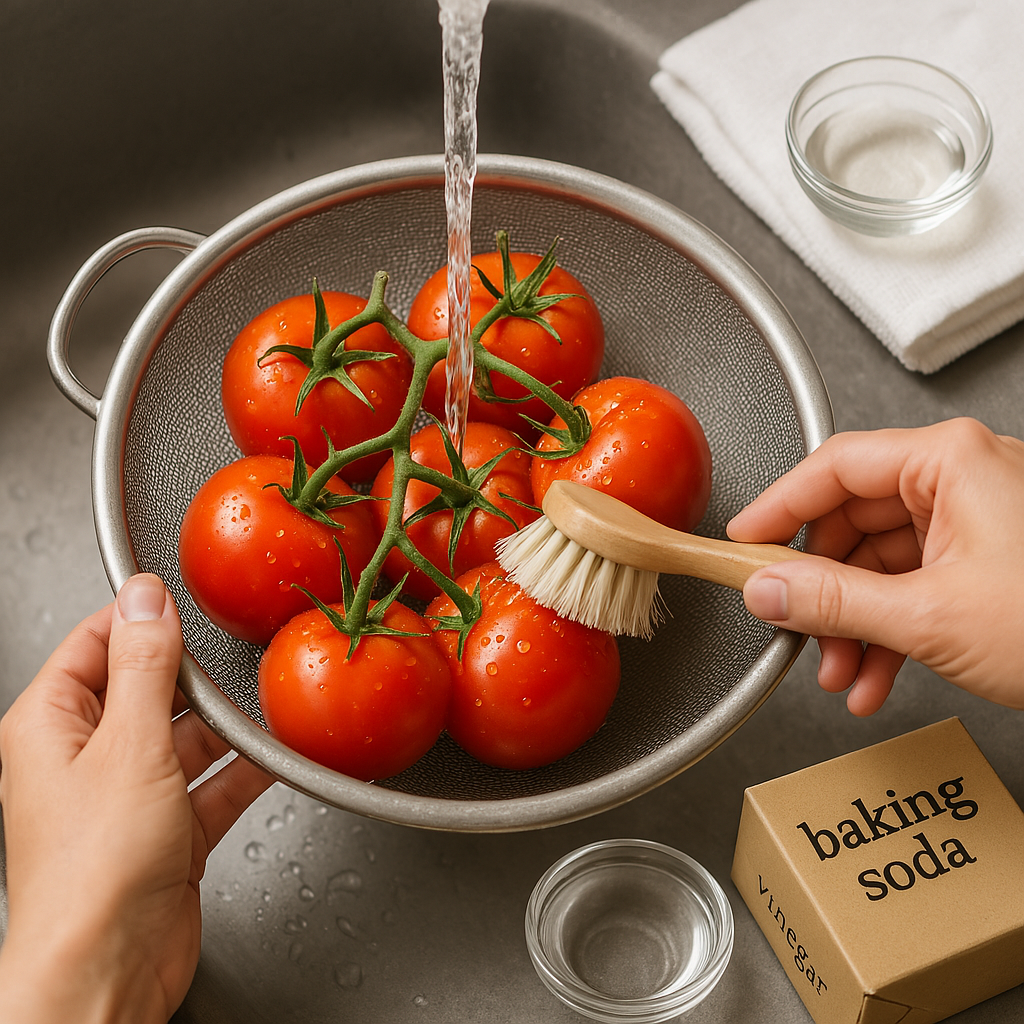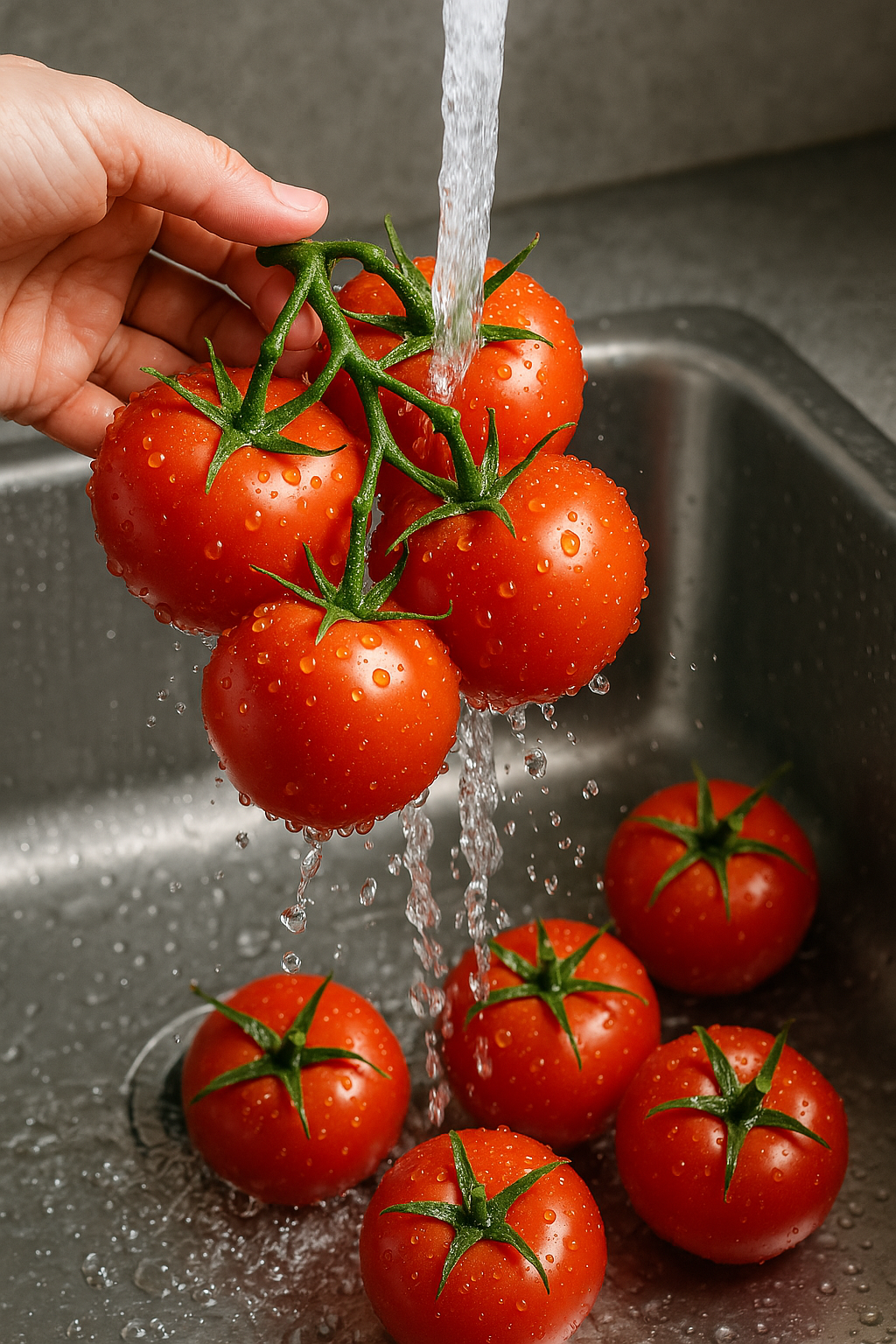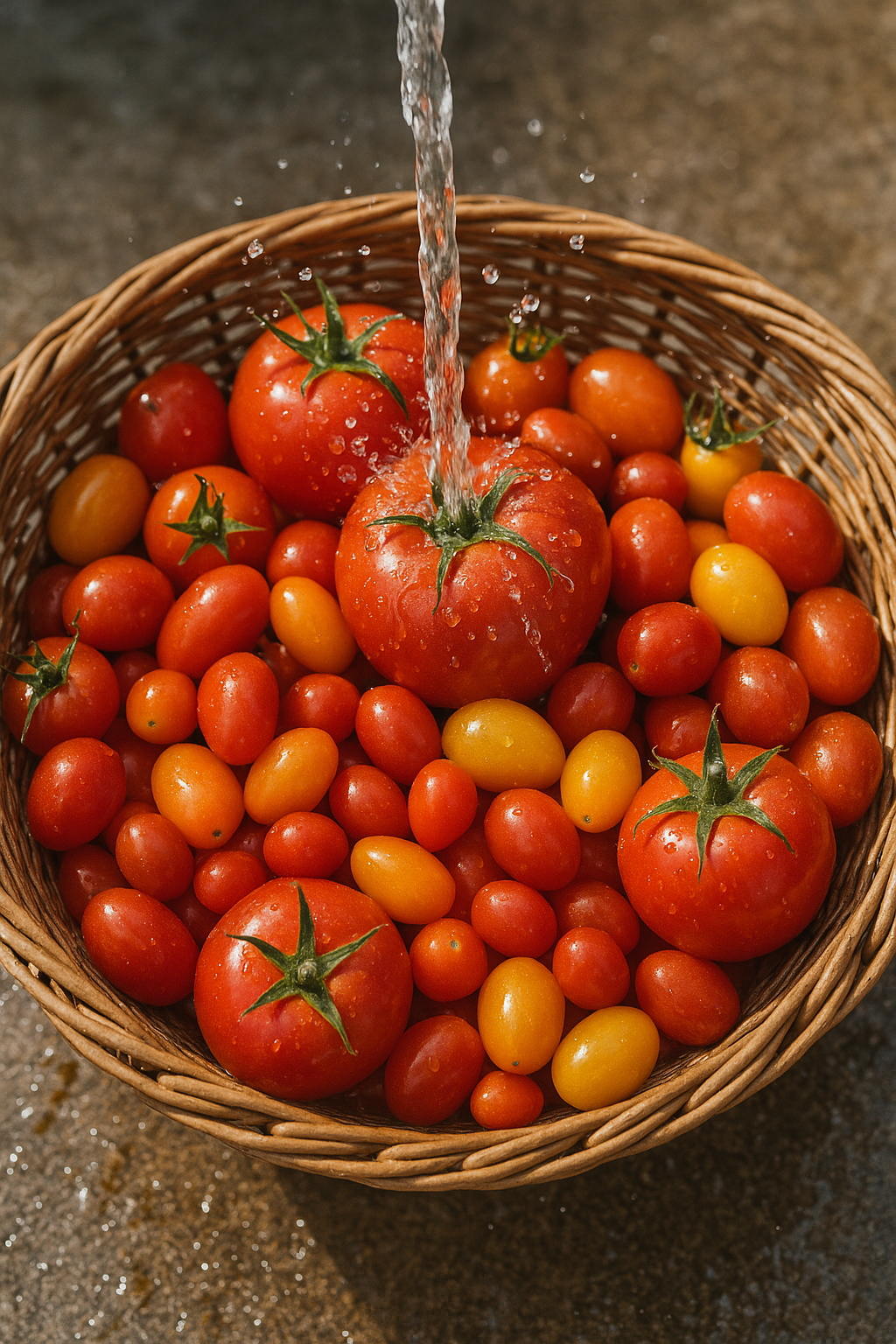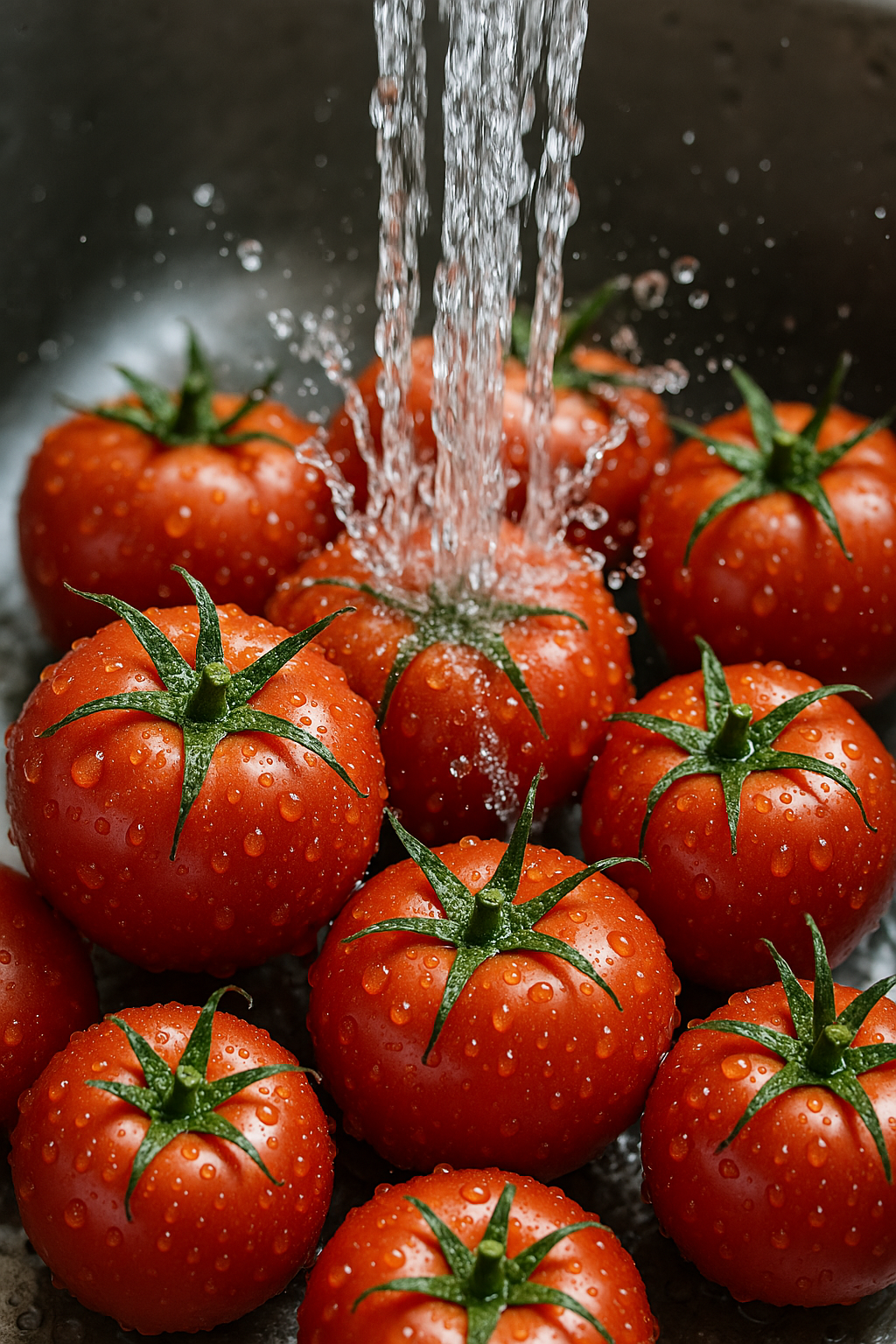Tomatoes are among the most popular and versatile fruits used in kitchens around the world.
From salads and sandwiches to sauces and soups, they are a staple in countless dishes.
But before you slice into a juicy tomato or toss it into your cooking pot, it’s crucial to wash it properly.
It is important to wash the tomatoes like most fresh produces, tomatoes can carry dirt, pesticides, bacteria, and other harmful contaminants on their skins.
Washing tomatoes the right way is a simple but essential step in food preparation.
This article will guide you through why it’s important, what you’ll need, different methods of washing, common mistakes to avoid, and how to store tomatoes after cleaning.
Why It’s Important to Wash Tomatoes

Even if your tomatoes look clean, they might not be clean. Here are some of the risks associated with unwashed tomatoes:
1. Pesticide Residue
Most conventionally grown tomatoes are treated with pesticides to ward off insects and diseases. While these chemicals are regulated, residues often remain on the surface after harvesting.
2. Dirt and Debris
Tomatoes grow close to the ground and may come into contact with soil, sand, or other environmental particles that stick to the skin.
3. Pathogens
Tomatoes can harbor pathogens like Salmonella, Listeria, and E. coli, which may originate from contaminated water, animal waste, or improper handling during harvest, packaging, or transport.
4. Wax Coatings
Many commercial tomatoes are coated with a thin layer of food-grade wax to extend shelf life and improve appearance. While not harmful, this coating can trap dirt and pesticides underneath.
What You’ll Need To Wash The Tomatoes Properly

Washing tomatoes doesn’t require special tools, but having the right items on hand can make the process more effective:
- Clean running water (cool or lukewarm)
- A colander or strainer
- A soft produce brush (optional)
- Clean paper towels or a cloth towel
- White vinegar or baking soda (optional for deeper cleaning)
Step-by-Step Guide on How to Wash Tomatoes

There are several ways to wash tomatoes depending on your preferences and what’s available to you. Here’s a standard method recommended by food safety experts:
Wash Your Hands
Always start by washing your hands thoroughly with soap and warm water for at least 20 seconds. This prevents you from transferring bacteria from your hands to the fruit.
Rinse Under Running Water
Place the tomatoes in a colander or hold them individually under cool running water. Gently rub each tomato with your fingers to dislodge any visible dirt or particles. Avoid using hot water as it can damage the skin and affect texture.
Use a Soft Brush (Optional)
If the tomatoes have visible dirt or you want to be extra cautious, use a soft produce brush to scrub the surface gently. This is especially useful for firmer varieties like plum or Roma tomatoes.
Consider a Vinegar Soak (Optional)
For a more thorough clean, especially if you’re concerned about pesticides or bacteria:
Mix a solution of 1 part white vinegar to 3 parts water.
Soak the tomatoes for 5–10 minutes.
Rinse thoroughly under clean running water afterward to remove any vinegar taste.
Dry the Tomatoes
Use a clean towel or paper towel to pat the tomatoes dry. Removing excess moisture helps prevent mold growth and extends shelf life.
Baking Soda & Salt Soak
If vinegar isn’t available or you prefer a different approach, you can use baking soda or salt:
Add 1 teaspoon of baking soda to a large bowl of water.
Stir to dissolve.
Soak tomatoes for 10–15 minutes.
Rinse thoroughly and dry.
Mix 1 tablespoon of salt in a quart of warm water.
Let the tomatoes soak for 10 minutes.
Rinse well under cool water and dry.
These methods can help remove pesticide residues and kill surface bacteria.
Washing Different Types of Tomatoes

Not all tomatoes are the same. Here’s how to adapt your washing method:
Cherry or Grape Tomatoes
These smaller varieties can be washed together in a colander.
Swish them gently under running water or soak briefly in a cleaning solution.
Be gentle, as their skins can be delicate.
Heirloom Tomatoes
Often grown organically and more delicate, heirloom tomatoes should be washed just before use.
Use minimal pressure to avoid bruising or cracking.
Tomatoes on the Vine
You can wash them while still attached to the vine, but make sure to rinse in all the crevices.
Be extra gentle to avoid breaking the vine and bruising the fruit.
When Not to Wash Tomatoes
Washing tomatoes immediately after purchase may seem like a good idea, but it’s not always recommended—especially if you don’t plan to eat them right away.
Why Wait to Wash?
Moisture can speed up spoilage and mold growth.
Washed tomatoes should be thoroughly dried before storage.
It’s best to wash tomatoes right before eating or cooking with them.
How to Store Tomatoes After Washing
If you do wash your tomatoes in advance, proper storage is key to preserving their freshness:
- Dry Completely – Use a towel to remove all moisture.
- Store at Room Temperature – Uncut tomatoes should be stored stem-side down on the counter.
- Avoid the refrigerator if they’re not fully ripe—it dulls the flavor and changes texture.
- Refrigerate Only When Cut – Once sliced or chopped, tomatoes should be stored in an airtight container in the fridge and used within 2–3 days.
Common Mistakes to Avoid

Here are some common pitfalls to be aware of:
1. Using Soap or Detergent
Never use dish soap or other household cleaners. Tomatoes are porous and can absorb chemicals, making them unsafe to eat.
2. Washing with Hot Water
Hot water can damage the skin and cause the tomato to become mushy.
3. Rough Scrubbing
Using a stiff brush or too much pressure can bruise or break the skin, accelerating spoilage.
4. Skipping the Drying Step
Moisture is a breeding ground for mold and bacteria. Always dry thoroughly before storing.
Final Thoughts
Washing tomatoes may seem like a minor step in your kitchen routine, but it plays a vital role in ensuring food safety and flavor. By following simple techniques—rinsing under clean water, using optional natural solutions like vinegar or baking soda, and drying thoroughly—you can enjoy your tomatoes with confidence.
Whether you’re preparing a fresh Caprese salad, simmering a rich marinara, or simply slicing one for a sandwich, clean tomatoes make for a safer, more enjoyable meal.
Leave a Reply